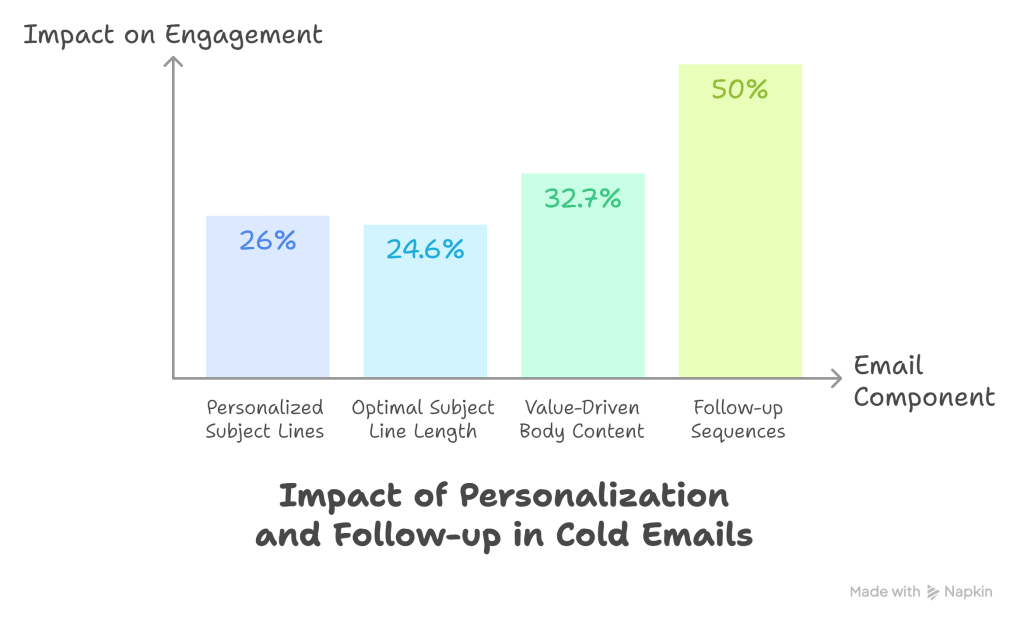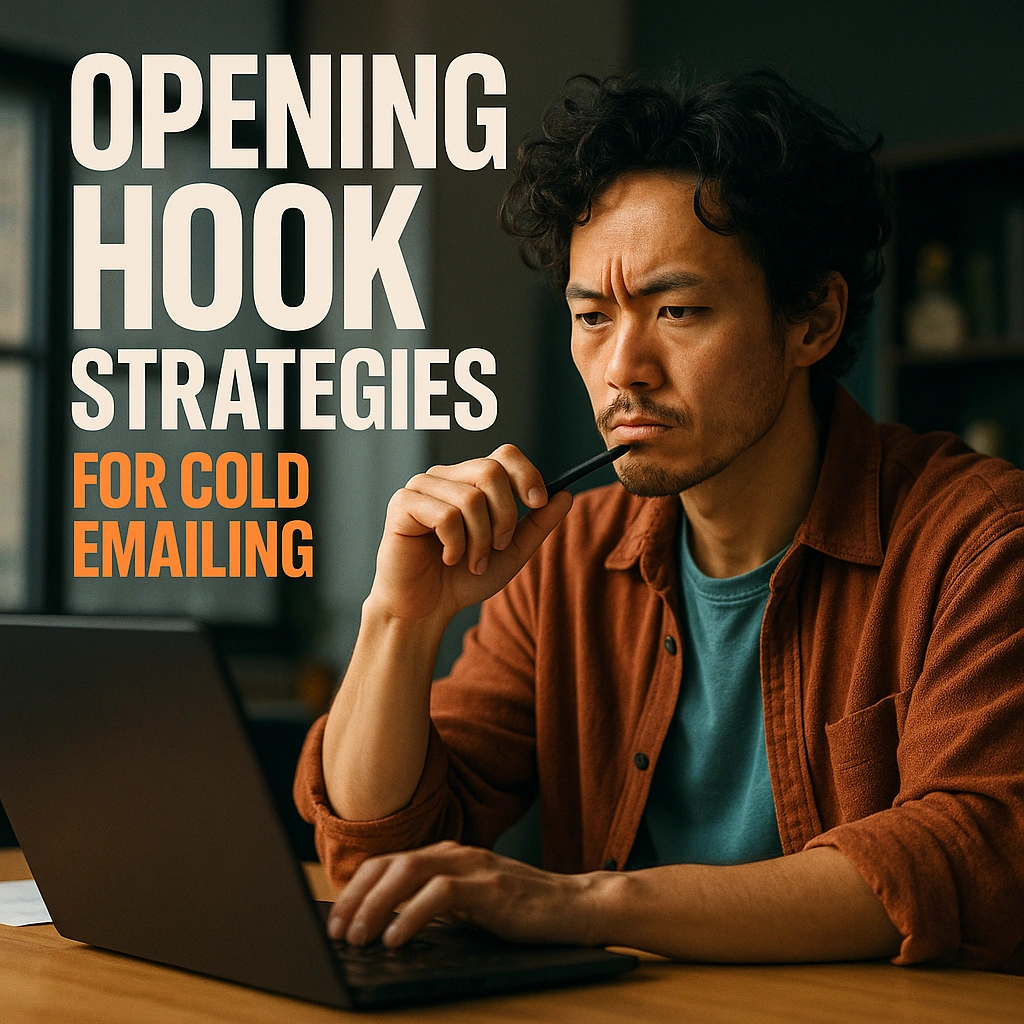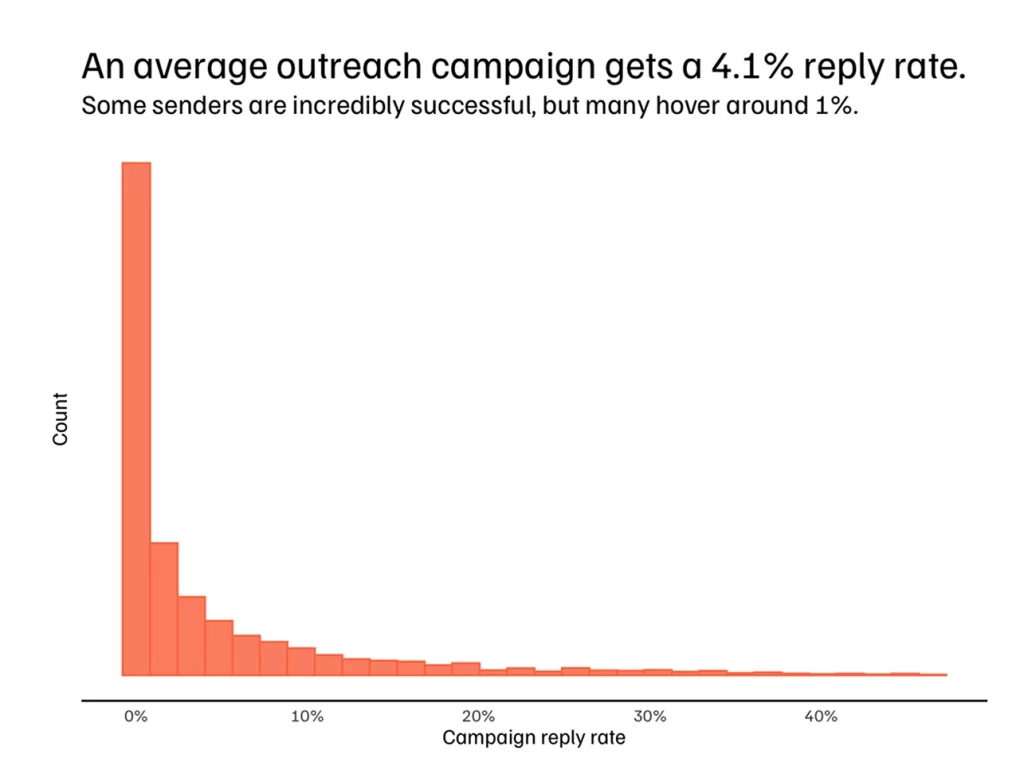A shocking 48% of marketers skip follow-ups entirely, despite follow-up sequences contributing 50% of cold email reply rates. This statistic reveals a fundamental misunderstanding of what drives cold email success. The 30 30 50 rule cold emails framework challenges this approach by allocating effort strategically: 30% to personalized subject lines and openings, 30% to value-driven body content, and 50% to systematic follow-ups and clear calls-to-action.
Recent data from Hunter.io shows campaigns implementing this structure achieve 18%+ reply rates compared to the industry average of 1-5%. The shift represents a departure from traditional cold email strategies that prioritize crafting perfect individual messages over building comprehensive outreach systems. Companies adopting this framework report conversion rates between 5-10% versus the standard 1.5-3%.
The methodology forces sales teams to invest more time in sequence design and follow-up automation rather than perfecting single touchpoints that often go unanswered.
Contents
- 1 Key Takeaways
- 2 Understanding the 30/30/50 Cold Email Framework
- 3 Mastering the First 30%: Personalized Subject Lines and Opening Hooks
- 4 Crafting the Second 30%: Value-Driven Body Content That Converts
- 5 Maximizing the Final 50%: CTAs and Strategic Follow-Up Sequences
- 6 Performance Benchmarks and 2025 Success Metrics
- 7 Critical Mistakes That Kill Cold Email Success
- 8 FAQ
- 9 Sources
Key Takeaways
- The 30 30 50 rule allocates 30% effort to personalized openings, 30% to value-driven content, and 50% to CTAs and follow-up sequences
- Campaigns using this framework achieve 18%+ reply rates compared to the industry average of 1-5%
- Personalized subject lines generate 26% higher open rates with optimal lengths of 36-50 characters
- Follow-up sequences spaced 2-4 days apart increase reply rates by 50% with 93% of responses occurring after the second email
- Direct CTAs like “Schedule a 12-minute call” outperform vague requests by 202%
Understanding the 30/30/50 Cold Email Framework
The 30/30/50 rule represents a data-driven approach to cold email resource allocation. Unlike traditional methods that focus heavily on crafting individual messages, this framework emphasizes systematic distribution across three critical components.
Core Structure Breakdown
The first 30% encompasses personalized subject lines and opening hooks. This component addresses the primary barrier to cold email success: getting noticed in crowded inboxes. Research from Apollo Technical demonstrates that personalized subject lines generate 26% higher open rates, while optimal lengths of 36-50 characters produce 24.6% higher response rates.
The second 30% focuses on value-driven body content that resonates with recipient pain points. This segment requires hyper-personalization based on behavioral data and company-specific triggers. Emails incorporating recipient achievements or industry challenges increase engagement by 32.7%.
The final 50% dedicates resources to clear calls-to-action and systematic follow-up sequences. This allocation reflects the reality that most responses occur after multiple touchpoints. Studies show 93% of replies happen after the second email, making follow-up automation essential for campaign success.

Performance Correlation Data
Companies implementing the 30/30/50 structure report measurable improvements across key metrics. Open rates increase from industry standard 22.99% to 27.7-60%. Reply rates jump from 1-5% to 10-18%. Conversion rates improve from 1.5-3% to 5-10%. These improvements stem from the framework’s emphasis on systematic follow-up rather than single-touch perfection.
The methodology aligns with modern buyer behavior patterns. B2B decision-makers receive 120+ emails daily, making breakthrough increasingly difficult. The 30/30/50 approach acknowledges this reality by investing heavily in sequence design and multiple value-adds rather than relying on individual message quality alone.
Mastering the First 30%: Personalized Subject Lines and Opening Hooks
The opening 30% determines whether recipients engage with your outreach. This component requires technical precision and strategic personalization to achieve inbox placement and initial engagement.
Subject Line Optimization Tactics
Effective subject lines balance personalization with brevity. Research from Klenty shows optimal character counts between 36-50 characters produce 24.6% higher response rates. Personalized subject lines incorporating recipient names or company references generate 26% higher open rates compared to generic alternatives.
Avoid spam trigger words like “free,” “urgent,” or “limited time.” Instead, reference specific company achievements, recent funding rounds, or industry challenges. Subject lines mentioning recipient accomplishments or pain points increase engagement by 32.7%. Examples include “Congrats on the Series B, [Name]” or “[Company] scaling challenges.”
Opening Hook Strategies
First sentences must immediately establish relevance and credibility. Generic greetings like “I hope this email finds you well” reduce engagement rates significantly. Using recipient last names instead of first names improves open rates by 12% while maintaining professional distance.
Reference specific company triggers like product launches, executive changes, or market expansions. These opening hooks demonstrate research depth and create immediate relevance. DejaFlow research shows emails incorporating behavioral data and company-specific triggers yield 41% more clicks and 202% higher conversions.

Technical Deliverability Requirements
Sender reputation scores must exceed 80 for optimal inbox placement. TrulyInbox data shows reputation scores above this threshold achieve 87.2% inbox placement rates. Maintain clean email lists, implement proper authentication protocols, and monitor bounce rates below 2% to preserve sender credibility.
Domain warming becomes essential for new outreach campaigns. Gradually increase sending volumes over 2-4 weeks to establish positive sender reputation. Tools like TrulyInbox provide domain warming services and inbox placement tracking to maintain deliverability standards.
Crafting the Second 30%: Value-Driven Body Content That Converts
The middle 30% transforms initial interest into genuine engagement through targeted value delivery. This component requires industry-specific knowledge and behavioral personalization to resonate with recipient priorities.
Conciseness and Structure Principles
Sub-100-word emails achieve 50% higher open rates than longer versions. This constraint forces focus on essential value propositions while respecting recipient time constraints. Include 1-3 hyperlinks for 15% CTR boost while avoiding excessive link density that triggers spam filters.
Structure content around recipient pain points rather than product features. SaaS emails require problem/solution alignment to achieve 2.5-4.5% conversion rates. Finance messages need compliance-focused language to reach 1-2.5% conversions. Industry-specific approaches significantly outperform generic messaging across all sectors.
Hyper-Personalization Benchmarks
Behavioral data drives the most effective personalization strategies. Reference recent company announcements, hiring patterns, or technology stack changes to demonstrate research depth. Emails incorporating these triggers yield 202% higher conversions compared to demographic personalization alone.
Company-specific triggers include funding rounds, executive changes, product launches, or market expansions. These events create natural conversation starters while establishing immediate relevance. Zembula research shows hyper-personalized emails based on behavioral data generate 41% more clicks than standard personalization approaches.
Industry-Specific Content Optimization
Different industries require distinct messaging approaches for maximum effectiveness. SaaS companies respond to efficiency and scalability benefits. Financial services prioritize compliance and risk mitigation. Healthcare focuses on patient outcomes and regulatory adherence. Industry alignment significantly impacts conversion rates across all sectors.
Tailor value propositions to industry-specific challenges and success metrics. Reference relevant case studies, industry benchmarks, or regulatory requirements to establish credibility. This approach transforms generic outreach into targeted business development that resonates with decision-maker priorities.
Maximizing the Final 50%: CTAs and Strategic Follow-Up Sequences
The final 50% allocation represents the framework’s most critical component. This emphasis on systematic follow-up reflects the reality that most B2B responses occur after multiple touchpoints rather than initial contact.
Direct CTA Design Principles
Specific calls-to-action outperform vague requests by 202%. Replace generic phrases like “learn more” with direct proposals like “Schedule a 12-minute call” or “Review our 3-minute demo.” Time-bound offers generate 13.44% higher CTR than open-ended requests.
Position CTAs in the final 1-2 sentences while occupying 50% of visual space. This placement ensures maximum visibility while maintaining email flow. Avoid multiple competing CTAs that dilute response focus. Single, clear actions generate higher conversion rates than complex decision trees.
Follow-Up Sequence Architecture
Deploy 3-5 sequenced follow-ups spaced 2-4 days apart to increase reply rates by 50%. Each touchpoint must provide new value rather than repeating initial messages. Include case studies, industry reports, or relevant metrics to justify continued engagement and demonstrate ongoing value.
Sequence timing affects response rates significantly. Tuesdays 9-11 AM local time generate 24% open rates, making this window optimal for follow-up deployment. Avoid Mondays and Fridays when inbox competition peaks and attention spans decrease. Strategic timing amplifies message effectiveness across all sequence stages.
Response Window Optimization
93% of replies occur after the second email, validating the 50% allocation to follow-up sequences. This data contradicts common practices that emphasize initial message perfection over systematic follow-up. Martal research shows campaigns with proper follow-up cadences achieve 10-18% reply rates compared to 1-5% single-touch approaches.
Include new value in each follow-up to justify continued contact. Share relevant case studies, industry insights, or competitive intelligence that relates to recipient challenges. This approach transforms follow-ups from annoying persistence into valuable business intelligence that recipients appreciate.

Performance Benchmarks and 2025 Success Metrics
The 30/30/50 framework produces measurable improvements across all key performance indicators. These benchmarks provide realistic expectations for campaign planning and resource allocation.
Open Rate Improvements
Standard industry open rates average 22.99% across all sectors. Campaigns implementing the 30/30/50 structure achieve 27.7-60% open rates depending on industry and implementation quality. This improvement stems from enhanced subject line personalization and sender reputation management. Deliverability optimization accounts for significant performance gains.
SaaS companies report the highest open rates at 45-60% when combining personalized subject lines with proper domain warming. Financial services achieve 35-45% open rates despite stricter compliance requirements. Healthcare and manufacturing sectors reach 27-35% open rates with industry-specific messaging.
Reply Rate Transformations
Industry standard reply rates range from 1-5% for most cold email campaigns. The 30/30/50 framework elevates reply rates to 10-18% through systematic follow-up and value-driven content. This improvement represents a 3-4x increase in response generation from identical prospect lists. Follow-up sequences drive the majority of this improvement.
B2B service companies achieve the highest reply rates at 15-18% when implementing complete sequences with industry-specific value propositions. Software companies reach 12-15% reply rates with technical personalization and case study integration. Manufacturing and healthcare sectors achieve 10-12% reply rates despite longer decision cycles and complex buying processes.
Conversion Rate Acceleration
Standard conversion rates from cold email range from 1.5-3% across industries. The 30/30/50 approach increases conversions to 5-10% through improved qualification and systematic nurturing. This improvement reflects better prospect matching and more effective value communication. Conversion optimization requires alignment across all three framework components.
Professional services achieve 8-10% conversion rates with consultative messaging and case study integration. Technology companies reach 6-8% conversions through technical demonstrations and ROI calculators. Traditional industries achieve 5-6% conversions with longer nurturing sequences and relationship-building approaches.
Critical Mistakes That Kill Cold Email Success
Common implementation errors undermine even well-designed cold email campaigns. Understanding these pitfalls prevents resource waste and campaign failure.
Follow-Up Neglect
48% of marketers skip follow-ups entirely despite their 50% contribution to reply rates. This mistake stems from overemphasis on initial message perfection rather than systematic sequence design. Hunter.io research shows campaigns with proper follow-up achieve 5-10x higher response rates than single-touch approaches.
Follow-up sequences require new value in each touchpoint to justify continued contact. Repeating initial messages creates annoying persistence rather than valuable business development. Include case studies, industry reports, or competitive intelligence that relates to recipient challenges. Value-driven follow-up transforms persistence into appreciated business intelligence.

Generic CTA Implementation
“Learn more” links generate 13.44% lower CTR than time-bound, specific offers. This performance gap reflects the need for clear, actionable next steps rather than vague engagement invitations. Replace generic CTAs with specific proposals like “Schedule a 12-minute call” or “Review our 3-minute demo.” Specific actions reduce decision friction and increase response rates.
Multiple competing CTAs dilute response focus and reduce conversion rates. Single, clear actions generate higher response rates than complex decision trees. Position primary CTAs in the final 1-2 sentences while occupying 50% of visual space for maximum visibility.
List Hygiene Negligence
Unclean email lists cause 17% inbox failure rates and damage sender reputation permanently. This technical oversight undermines even well-crafted campaigns by preventing inbox delivery. Clean email lists quarterly using tools like Hunter.io to maintain deliverability standards.
Bounce rates above 2% indicate list quality problems that require immediate attention. High bounce rates trigger spam filters and reduce inbox placement across all campaigns. Implement proper email validation and remove inactive addresses regularly to preserve sender credibility.
FAQ
How does the 30/30/50 rule differ from traditional cold email approaches?
Traditional approaches focus heavily on crafting perfect individual messages. The 30/30/50 rule allocates 50% of effort to follow-up sequences and CTAs, recognizing that 93% of replies occur after the second email. This systematic approach achieves 18%+ reply rates versus 1-5% industry averages.
What tools are essential for implementing the 30/30/50 framework effectively?
Key tools include DejaFlow for behavioral personalization, TrulyInbox for deliverability monitoring, and Klenty for sequence automation. These platforms support the framework’s emphasis on systematic follow-up and technical optimization. Proper tool selection directly impacts campaign performance and efficiency.
How long should follow-up sequences be within the 50% allocation?
Deploy 3-5 sequenced follow-ups spaced 2-4 days apart for optimal results. Each touchpoint must provide new value through case studies, industry insights, or competitive intelligence. This cadence increases reply rates by 50% while maintaining recipient engagement throughout the sequence.
What industries benefit most from the 30/30/50 cold email structure?
SaaS companies achieve the highest success rates at 15-18% replies with technical personalization. Professional services reach 12-15% through consultative messaging. All industries benefit from the systematic approach, though implementation tactics vary based on buying cycles and decision-making processes.
Sources
- Growleady – Master Cold Emails: Explaining the 30 30 50 Rule
- Woodpecker – How I wrote a cold email that got a 50% reply rate
- Brandwell – What Is the Average Response Rate of Cold Emails in 2025?
- Coldlytics – What is Cold Email?
- Beehiiv – 50 Cold Email Stats
- Klenty – 21 Top Cold Email Statistics That Work In 2024
- DejaFlow – Cold Email Personalization: A Complete Guide
- QuickMail – The Complete 2024 Guide to Cold Email Metrics
- Zembula – 15 Email Personalization Stats for 2024
- Growleady – Cold Email Success Rate: Is It Still Effective in 2025?
- TrulyInbox – Top 15 Email Deliverability Statistics in 2025
- Apollo Technical – 51 Cold Email Statistics That Matter In 2025
- Martal – 2025 Cold Email Statistics: B2B Benchmarks
- Labnify – What is the 30 30 50 Rule for Cold Emails?
- Hunter.io – The state of cold email 2025

